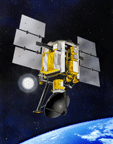
Oceanweather
has been active in remote sensing research since its founding,
particularly in the development of satellite active microwave
remote sensing of the sea surface. Dr. Cardone, prior to
co-founding Oceanweather Inc., became involved in the earliest
stages of research on the development and evaluation of
microwave remote sensors to measure ocean roughness, winds
and sea state. He personally participated in many aircraft
missions into severe storms during the 1960s to help evaluate
prototype sensors. He later contributed to NASA's SKYLAB
mission to evaluate the effectiveness of the first spaceborne
radar scatterometer, S193. Oceanweather contributed to the
evaluation of both the scanning multichannel microwave radiometer
(SMMR) (Cardone et al., 1979, 1983) and the scatterometer
(SASS) on SEASAT (Wentx et al., 1982).
 The
potential of global scatterometer data to positively impact
global numerical weather prediction was demonstrated in
a study carried out jointly with the NASA Goddard Space
Flight Center (Cane et al., 1981). Oceanweather collaborated
with the research team at Columbia's Lamont Doherty Geological
Observatory to evaluate the impact of scatterometer data
acquired during the NASA NSCAT mission on tropical ocean
modeling, wind field analysis, climate assessment and other
areas in air-sea interaction.
The
potential of global scatterometer data to positively impact
global numerical weather prediction was demonstrated in
a study carried out jointly with the NASA Goddard Space
Flight Center (Cane et al., 1981). Oceanweather collaborated
with the research team at Columbia's Lamont Doherty Geological
Observatory to evaluate the impact of scatterometer data
acquired during the NASA NSCAT mission on tropical ocean
modeling, wind field analysis, climate assessment and other
areas in air-sea interaction.
A separate research program funded by the US Weather Research
Program evaluated the potential of NSCAT to diagnose the
wind field and the intensity of tropical cyclones (Jones
et al., 1999, Cardone et al., 1999). The NASA QuikSCAT mission
has by mid-2000 provided a two-year global data base of
high quality scatterometer and several research projects
are underway at Oceanweather.
One
program supported by NASA Jet Propulsion Laboratory seeks
to validate the scatterometer model function to high winds
and to utilize the data to develop high quality wind fields
in severe storms. Another project, funded by Office of Naval
Research in part continues the previous work to explore
and exploit the QuikSCAT data for tropical cyclone diagnosis
and prediction (Cox and Cardone, 2000). Oceanweather has
also integrated the use of QuikSCAT data as appropriate
in its global and regional hindcast studies and real time
forecast operation.
REFERENCES
1979.
Cardone, V. J. with 10 co-authors. Surface observations
for the evaluation of geophysical measurements from SEASAT.
Science, 204, 1408 -1410.
1981.
Cane, M. A., V. J. Cardone, M. Halem and I. Halberstam.
On the sensitivity of numerical weather prediction to remotely
sensed marine surface winds data: a simulation study. J.
of Geophys. Res., 86, 8093-8106.
1982.
Wentz, F. and V. J. Cardone. Intercomparison of wind speeds
inferred by the SASS, Altimeter and SMMR. J. of Geophys.
Res., 87, 3378-3384.
1983.
Cardone, V. J., T. Chester and R. Lipes. Evaluation of SEASAT
SMMR wind speed measurements. J. of Geophys. Res., 88, 1709-1726.
1999.
Jones, W. L., V. J. Cardone, W. J. Pierson, J. Zec,
L. P. Rice, A.T. Cox, W. B. Sylvester. NSCAT high-resolution
surface wind measurements in Typhoon Violet. J. Geophys.
Res., 104(C5), 11247-11259.
1999.
Cardone, V. J., A. T. Cox W. J. Pierson, W. B. Sylvester,
W. L. Jones,J. Zec. (1999) NASA scatterometer high resolution
winds for Hurricane Lili. International Geoscience and Remote
Sensing Symposium (IGARRS'99) 28 June - 2 July, 1999, Hamburg.
2000
Cox, A. T. and V. J. Cardone. Operational system for the
prediction of tropical cyclone generated winds and waves.
6th International Workshop on Wave Hindcasting and Forecasting,
November 6-10, 2000, Monterey, CA.

